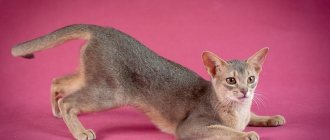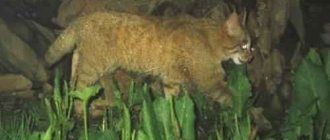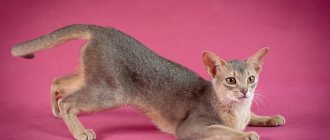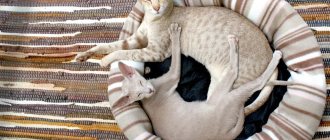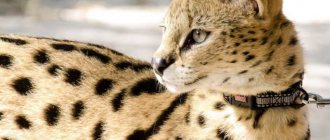- Wild animals
- >>
- Mammals
Serval is one of the most mysterious and amazing representatives of the cat family. The spotted predator, which came from Africa, feels quite comfortable at home. This representative of the cat family has amazing beauty and luxurious fur, which is of great value. In this regard, cats that live in natural conditions are hunted. This is the reason for the rapid decline in their numbers.
Origin of the species and description
Photo: Serval
The serval is a carnivorous mammal, classified in the genus Serval, a species of bush cat. To date, zoologists have identified 14 subspecies of this species. Initially, there were many more of them, and they densely populated the African continent. Initially, the inhabitants of the African continent called the graceful beauties “serval cat.” However, later scientists came to the conclusion that this was not quite the correct name and began to call it “serval”.
Many of the existing subspecies have been exterminated in large numbers, one of them is listed in the Red Book as endangered.
At the end of the last century, these animals attracted the attention of zoologists, who decided to try to domesticate the incredibly beautiful and graceful wild cats. The attempts turned out to be very successful, since the animal quickly adapts to the changed conditions of detention and feels quite comfortable as a pet. Felinologists even carried out hybridization and bred two breeds of domestic cats - Savannah and Asherah.
Servals have also been successfully crossed with caracals. Born kittens are called servicals or caravals. Today, servals are considered very expensive and elite pets, which not everyone can afford to have.
Health
The advantage of the breed is the absence of characteristic hereditary diseases. But, like any cat, the African predator has its weaknesses.
- Does not tolerate cold, drafts, or temperature changes. Close windows and room doors before swimming. Do not walk your cat outside for long periods of time in the fall and winter.
- Serval is not suitable for some vaccinations with active viruses. A wrong step by the owner can cost the pet's life. Consult an experienced veterinarian before vaccinating.
- Tendency to diarrhea. Watch your diet carefully. It is recommended to coordinate the diet with your veterinarian.
- Possibility of injury due to outdoor games and jumping. Kittens are especially susceptible to damage, since the bones of the limbs are still poorly formed.
The breed is long-lived. With caring attitude, proper care and proper nutrition, the life expectancy of a cat is 15-20 years.
Appearance and features
Photo: Serval animal
The serval is a wild cat of amazing beauty. External characteristics are similar to a lynx or a golden cat. They are also similar to large, robust and strong house cats. The body length of one adult individual is 80-140 centimeters. The height of the body at the withers is 40-70 centimeters. The body weight of an adult is 18-22 kilograms. The animals have a small but thick tail, the length of which is 20-35 centimeters.
Servals have a small head relative to their body size. The muzzle looks like the muzzle of a lynx. Servals have large, long ears, which are considered to be the “calling card” of the animal. They are located high and abundantly covered with wool on the inside. The area of the nose and bridge of the nose are wide, the nose is most often black. The eyes are almond-shaped, very expressive, light.
Video: Serval
These representatives of the cat family have a very flexible, slender and toned body. They also have flexible, thin and very graceful limbs. Among all representatives of the cat family, they have the longest limbs relative to the body. The hind limbs are slightly longer than the forelimbs. These representatives of the cat family have very strong, well-developed muscles.
The coat is short and thick, very shiny. The color resembles the coat of a cheetah. The color scheme is dominated by golden gray. In the area of the neck, chest and belly the coat is lighter, milky or white. Against the background of golden-gray or milky wool there are spots and stripes of black. The color of the coat is largely determined by the region of residence.
Animals that live in the steppes have a lighter color and large spots, animals that live in forests have a darker, almost brown color. There are also black servals that live in the mountain ranges.
Where does the serval live?
Photo: Serval cat
Under natural conditions, servals live exclusively within the African continent. At home, they are found in different regions and continents. They mainly inhabit open areas with bushes and thickets of grass. The main requirement of wild cats for their habitat is the presence of trees to climb and a body of water to swim in. They can inhabit mountainous areas, as well as the edges of forests. Deserts and dry plains are not suitable as a habitat region.
Geographical regions of distribution of servals:
- Uganda;
- Angola;
- Guinea;
- Togo;
- Algeria;
- Kenya;
- Morocco;
- Ethiopia.
African wild cats are distributed in varying densities throughout almost the entire continent. The exception is the Sahara Desert, the Cape Province and the equator zone. In regions north of the Sahara, the graceful predator is a rare visitor, but in East and West Africa it is quite common. Almost half of all individuals existing in nature inhabit mountainous or hilly areas.
What does a serval eat?
Photo: African serval
Wild cats are carnivores by nature, and the basis of their diet is meat.
Servals are leaders among predatory animals in terms of hunting success. Zoologists claim that approximately 60% of prey as a result of hunting becomes food for skilled hunters. For comparison, it is worth noting that the success rate of hunting tigers or lions does not exceed 40%.
What is the food supply for wild cats:
- hares;
- hyraxes;
- small antelopes;
- flamingo;
- guinea fowl;
- feathered eggs;
- lizards;
- rodents;
- snakes;
- frogs;
- fish.
By nature, wild cats are endowed with excellent hearing and lightning-fast reactions, which help track prey even at great distances. Zoologists claim that more than 90% of serval prey weighs no more than 200 grams, and only 2-3% have a body weight exceeding 2/3 of the body weight of a small female individual.
Servals typically eat food of plant origin to obtain minerals and coarse fiber. Due to the fact that wild cats tend to be nocturnal, they also go hunting mainly at night. They are most active in searching and obtaining food at 10-12 pm and 3-5 am. In some cases, they may go hunting during the daytime.
Servals are considered skilled hunters. Their constitution and body structure contribute to this. They have long ears, which provide very subtle and insightful hearing, as well as long, graceful limbs. They make it easier to move through bushes and thickets, and also allow cats to make masterly jumps.
Zoologists say that servals have such acute hearing that they can even hear the trembling of a mouse or other small rodent at a distance of up to a kilometer.
Animals prefer to hunt by tracking prey and approaching it through dense thickets. When she is within range, the serval attacks her with a lightning-fast leap.
Features of character and lifestyle
Photo: Serval Red Book
Graceful and incredibly beautiful predators are agile, fast and dexterous animals. When living in natural conditions, they prefer to lead a solitary, hidden lifestyle and avoid conflicts. They love to climb trees and branches. That is why, when keeping a wild cat at home, it is necessary to take care of the presence of branches on which they can climb. You can build shelves in several tiers.
Another weakness and hobby of graceful animals is water. Despite the fact that it is commonly believed that cats are afraid of water, servals simply adore water treatments. Playful by nature, they love to splash and play with water. Breeders of these wild cats should take into account the fact that they love to chew various objects and can easily ruin expensive furniture and interior items. Serval breeders note that they get along quite well with dogs, especially large breeds.
Also, these representatives of the cat family are distinguished by their rather playful character, curiosity and sociability. They carry all the habits of wild cats with them into their “home life.” Just as when living in natural conditions, they tend to mark their territory, and this is typical for both male and female individuals.
If animals sense the approach of danger or threat, they prefer to flee, abruptly changing the trajectory of movement and performing unpredictable maneuvers and jumps. As pets, servals show love, affection and great devotion to a caring and loving owner.
Animals are considered very smart and quick-witted. However, at the same time, secrecy and fear are also inherent in African predators. If animals are kept at home, then when strangers appear, they hide and try to stay away. In natural conditions they also show caution and prudence. To communicate with each other, animals use several types of sounds: piercing sounds and screams, purring, growling.
Upbringing
When raising a serval, you need to show considerable patience, since the African serval has many features. Due to their good appetite, kittens eat a lot at a young age and can choke on foreign objects. In order to protect kittens, breeders should switch their attention to cat toys, and it is recommended to treat wires and valuables with a special anti-rodent spray, which can be found in a pet store.
During training, an extremely bad method of education is screaming and hitting the pet; a wild Serval cat can remember this. You should teach the cat clear and precise commands “you can’t” or “you can,” and if a Serval cat refuses to obey, you can use water from a spray bottle. You need to play with kittens using special toys, otherwise they may scratch their owner painfully. This breed needs to be walked outside often to stay in shape, so you need to teach the Serval to a leash from early childhood.
Before showing interest in this exotic breed of Serval cats, the breeder needs to study them in detail, how to properly care for, raise, feed and maintain them. To do this, you can talk with other serval owners and reputable cat owners, weigh the pros and cons. To ensure a comfortable life for a serval, a lot of free space is needed for its physical development, so it is not recommended to have cats in small living spaces. It is also extremely important to make sure that the cats are licensed and that the seller does not violate applicable laws.
Social structure and reproduction
Photo: Serval kitten
The mating season among servals is not tied to a specific season. Thanks to this, at home they give birth at any time of the year under good conditions and proper care. In individuals that live in the southern regions, offspring are most often born in early or mid-spring. Animals living in the tropics have their babies born at different times of the year. During the period of mating in nature, animals form a pair and exist together for some time. They spend their free time together and hunt together.
Pregnancy lasts 77-79 days. When the time comes to give birth, animals look for a suitable place for this. As such, servals use aardvark burrows or nests in thickets of dense vegetation.
Several are born at once, but usually no more than four kittens. They are blind and covered with light down. Eyes open on days 13-17. Kittens feed on mother's milk until they are 6-8 months old. The babies are very voracious, and the female loses significant weight during the period of feeding her offspring. They grow and get stronger quite quickly. At three months of age, their weight relative to birth weight doubles.
At 4-5 months, the female gradually takes them out to hunt, teaches them hunting skills and introduces them to regular meat food. Males reach puberty by two years, females by one and a half years. At about a year old, the cubs separate from their mother and begin to lead a separate lifestyle. The average life expectancy is 13-15 years; if kept in good conditions, they can live up to 20 years.
Servals are considered very caring and tender mothers. During the period when the babies depend on her and are helpless, the female is very dangerous and aggressive. When she senses the slightest threat to the kittens, she rushes to their defense and can even attack her beloved owner.
Breeding
The African serval is a loner, but during the mating period, natural instincts take over. In natural habitats, male territories are adjacent to territories where many females live for optimal reproduction. Mating often occurs in the spring. The female herself looks for the male and cares for him before the estrus, which lasts only 1 day.
Breeding servals in captivity is impossible without some knowledge of this process. In the world of wildlife, the birth of kittens is a real miracle. Babies are born desired by everyone.
The gestation period lasts 10-11 weeks, 2-3 kittens weighing about 250 g appear in the litter. In the first 11 days, the weight of the babies doubles. Permanent canines appear at six months. Sexual maturity occurs at 18-24 months.
Interesting. Servals are not designed to breed in captivity, but if desired, they can produce wonderful offspring. This process becomes a kind of challenge for breeders: will the person cope or not?
During the breeding season, the behavior of animals changes: anxiety and excessive mobility appear. A cat may bite or scratch a person or other animal. Kittens can be born viable, but sometimes require human assistance.
If a cat becomes pregnant by a normal cat, she can kill the hybrid offspring. Therefore, the owner must be on alert. Such kittens weigh 90-110 g. Males remain infertile for three generations. Cats with a high percentage of wild blood may be fertile, but sometimes become parents of small litters. When kept in captivity for several generations, mating efficiency increases.
Natural enemies of servals
Photo: Serval cat
Almost the only enemy of wild cats that contributes to the reduction of their numbers is humans. Servals are killed in large numbers by poachers for their valuable fur. Serval cubs, which are highly valued by exotic animal breeders, are also of great value to poachers.
Under natural conditions, the enemies of wild cats are hyenas, wild dogs and leopards. They often hunt young amazing representatives of the cat family, or even adults.
The greatest threat to animal numbers comes from humans and their activities. Animals are shot not only because of the desire to profit from the sale of valuable fur, but also because of their tasty, tender meat, which is considered a great delicacy within the African continent. It also often happens that African cats cause damage to poultry farms.
For this reason, they are caught as pests and exterminators of poultry. In this regard, even in those regions where the number of bush cats was numerous, it has decreased significantly. The increase in the population of the African continent has led to a depletion of the food supply and the destruction of the natural habitat.
Nutrition
In nature, the serval cat is an excellent hunter, often playing with its prey before eating. It eats a variety of live food, usually anything available on the savannah, including rabbits, large rodents, birds, fish, insects, reptiles and frogs. Therefore, to care for such an animal at home, you will need a large amount of protein food.
To prevent a serval at home from yearning for the food of the wild African savannah, it is not necessary to catch grasshoppers with your own hands. It is enough just to create the right diet of raw meat (beef or chicken) and regularly buy food rodents and birds for your pet.
The diet must include a complex of vitamin and mineral supplements. Sometimes animals can be offered eggs (quail).
Population and species status
Photo: Serval
Despite the fact that the number of bush cats is declining, only one of the 14 subspecies is listed in the Red Book. The northern subspecies of the serval is listed in the Red Book with the status of “endangered species.” All existing subspecies of bush cats are listed in the second CITES convention.
To date, zoologists do not have clear data on the number of serval individuals. They are quite common in nurseries, aviaries, and also in the homes of wealthy and self-sufficient people in different countries.
At the legislative level, no laws have been adopted to protect animals. Also, no programs are specifically developed to preserve and increase their numbers. In some regions, representatives of the Rybnadzor and other bodies for the protection of flora and fauna are involved in animal protection. The law does not provide for any types of punishment for catching or shooting an animal.
In some regions, there is a trade in serval kittens, which are 1-2 months old. It is at this age that the cubs most quickly adapt to new environmental and maintenance conditions. Experts recommend taming kittens at a young age. Then they get used to people and learn to exist in a family environment among people.


